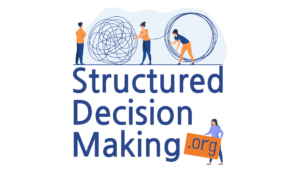Getting a good set of objectives
Start by Brainstorming!
You can brainstorm objectives by gathering a broad cross-section of people with an interest in the outcome of the decision and asking what concerns they’d like to see addressed. Specific questions that may be useful include:
- What are we trying to achieve by making this decision (or revising this policy, or making this plan, or tackling this issue)? What are the specific issues or concerns you’d like to see addressed?
- If the list is very long, ask people to think about the big categories of impacts that should be considered, and add sub-bullets under them.
- Think about key stakeholders. What would they be concerned about? Imagine you are explaining a proposed alternative to others (manager, colleague, decision maker, etc.), what questions would they ask?
- Ask yourself what you think would be a great alternative (even if you consider it infeasible). What makes it great? What would be a terrible alternative or outcome? Why? Answers to these questions could suggest more objectives.
- What are the hidden agendas or political “realities” that could thwart things despite a great analysis? These could be important but as-yet unstated objectives.
As a first cut, write down everything that is said.
State your objectives concisely
Next you’ll want to turn your brainstormed list into a set of concise objectives. Keep it simple. Objectives need only state two things:
- the thing that matters
- the direction you’d like it to move (more vs. less)
For example, objectives of park management plan may be to:
- Maximize Recreation Opportunities
- Minimize Net Management Cost
- Maximize Protection of Wildlife Habitat
Objectives of a recovery plan for a species at risk may include:
- Minimize the Probability of Extirpation
- Minimize Management Cost
- Minimize Impacts on Other Species
- Minimize Loss of Tourism Income.
Avoid use of objectives with an ambiguous direction (e.g., “Optimize chlorine concentration in the pool”). If there are problems from having too much or too little of something, break apart the original objective into its subcomponents to expose the trade offs that are inherent in the word ‘optimize’ (e.g., Instead of: “Optimize chlorine levels in the pool”, use both: “Minimize spread of disease in the pool” and “Minimize irritation of swimmers caused by water treatment”
Don’t be put off by the terminology of ‘maximize’ and ‘minimize’; these words are used because they clarify the preferred direction of change (e.g., more or less is better). For example, you needn’t worry that “maximize the abundance of white sturgeon in the Columbia River” may lead to the unwanted situation of too many of these endangered fish causing a problem – it’s obviously not going to happen – and if it were, then just state whatever objectives would be compromised by having too many sturgeon (loss of other species?). That said, if agreeing on the verbs is becoming a problem, you can usually drop them – just make sure the objectives have a single, clear, agreed preferred direction.
Test your draft objectives against hypothetical but plausible alternatives
The real litmus test of whether objectives are useful is whether they will help you evaluate, compare and choose among the alternatives you are considering. So test them! At this stage of the process you may not have detailed alternatives worked out, but you must at least identify the broad range of alternatives that are likely to be under consideration. Sketch out a rough consequence table (objectives by alternatives matrix). Ask yourself: “In choosing among these alternatives, are these the things that matter? Is anything missing?” For each alternative consider: “What would others be concerned about if I were to tell them that we had selected this alternative?” In sum, ask yourself: “If I collect information about the impacts of these alternatives on these objectives, using the proposed performance measures (i.e., imagine the consequence table filled with data, text or plusses and minuses in each cell), would we have all the information we would need to make this decision?”
What makes a good set of objectives?
There are no ‘right’ objectives in decision making. However, some are more useful than others. Useful objectives will be tailored to your decision frame. They will be (adapted from Keeney, 1992 and McDaniels, 2000, and Gregory et al 2012):
Complete – All the important consequences (affected values) of the decision are covered, including those that are hard to define or quantify;
Concise – all the important consequences are described with the fewest possible objectives and measures, with no redundancy or double counting.
Sensitive (sometimes called Controllable) – they are sensitive to the alternatives under consideration given the decision context and bounds;
Specific – Objectives themselves do not need to be measurable, but they do need to be conceptually clear and specific enough that performance measures can be later defined.
Understandable – Any interested person can understand what is meant by it. Using commonly understood terms rather than scientific jargon helps, as does stating each objective simply and concisely (verb + thing that matters).
To meet these desirable characteristics, it is often useful to build an Objectives Hierarchy. With this tool, similar objectives are grouped together by creating sub-objectives that define the components of the general objectives, and assigning a performance measure to each sub-objective. For example, “Conserve Biodiversity” is clearly stated, but may be interpreted in very different ways unless it is more clearly defined by lower-level objectives and specific performance measures that define how biodiversity is to be understood in this decision context.
Key Practice Tips
- Don’t prioritize objectives! At this stage, there is not enough information to prioritize or weight them, and in a multi-stakeholder setting, you are unlikely to get agreement.
- Different objectives will suit different decision problems. What is a means in one decision may be a fundamental objective in another. It depends on what other decisions have already been made, and whether you are making a broad strategic decision, or a specific operational or tactical one.
- For a given decision, or class of decisions, well-thought-out objectives normally remain relatively stable over time.
- Objectives should not be limited by data availability (performance measures on the other hand, may be).
- Watch out for moving too quickly to the easy objectives and ignoring the ones that are hard to define
- Don’t try to get it perfect the first time. Get a quick list and then test them with some sample alternatives. As you think about the alternatives and what their pros and cons are, you will come up with more objectives.

